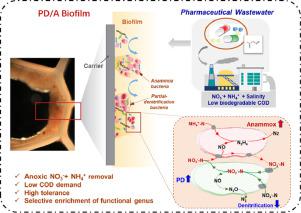Water Research ( IF 11.4 ) Pub Date : 2021-11-09 , DOI: 10.1016/j.watres.2021.117856 Jingwen Zhang 1 , Yongzhen Peng 1 , Xiangchen Li 1 , Rui Du 1

|
Biological nitrogen removal from pharmaceutical wastewater has drawn increasing attention due to biotoxicity and inhibition. In this study, for the first time, a novel approach integrating partial-denitrification with anaerobic ammonia oxidation (PD/A) in a sequencing biofilm batch reactor (SBBR) was proposed and demonstrated to be efficient to treat the bismuth nitrate and bismuth potassium citrate manufacturing wastewater, containing ammonia (NH4+-N) and nitrate (NO3−-N) of 6300±50 mg L − 1 and 15,300±50 mg L − 1. The maximum anammox activity was found at the shock effect of influent total nitrogen (TN) of 100 mg L − 1 with NO3−-N/NH4+-N of 1.0. Long-term operation demonstrated that the PD/A biofilm was developed rapidly after 30 days using synthetic influent, with TN removal efficiency increasing from 40.9% to 80.8%. Significantly, the key bacteria for PD/A had high tolerance and adapted rapidly to pharmaceutical wastewater, achieving a relatively stable TN removal efficiency of 81.2% with influent NH4+-N and NO3−-N was 77.9 ± 2.6 and 104.1 ± 4.4 mg L − 1 at a relatively low COD/NO3−-N of 2.6. Anammox pathway contributed to TN removal reached 83.6%. Significant increase of loosely-bound extracellular polymeric substances was obtained with increasing protein of 3-turn helices structure as response to the inhibitory condition. High-throughput sequencing analysis revealed that the functional genus Thauera was highly enriched in both biofilms (9.5%→43.6%) and suspended biomass (15.5%→57.5%), which played a key role in high NO2−-N accumulation. While the anammox bacteria decreasing from 7.8% to 1.6% in biofilm, and from 1.8% decreased to 0.1% in the suspended sludge. Overall, this study provides a new method of high-strength pharmaceutical wastewater treatment with low energy consumption and operation cost, as well as a satisfactory efficiency.
中文翻译:

部分反硝化/厌氧氨氧化混合生物膜反应器处理制药废水的可行性
由于生物毒性和抑制作用,从制药废水中生物脱氮越来越受到关注。在这项研究中,首次提出了一种将部分反硝化与厌氧氨氧化 (PD/A) 结合在顺序生物膜间歇式反应器 (SBBR) 中的新方法,并证明该方法可有效处理硝酸铋和柠檬酸铋钾。制造废水,含有6300±50 mg L - 1和15,300±50 mg L - 1 的氨(NH 4 + -N)和硝酸盐(NO 3 - -N)。在进水总氮 (TN) 为 100 mg L − 1的冲击作用下发现了最大的厌氧氨氧化活性 NO 3 - -N/NH 4 + -N为1.0。长期运行表明,使用合成进水30天后,PD/A生物膜发展迅速,TN去除效率从40.9%提高到80.8%。值得注意的是,PD/A关键菌对制药废水具有较高的耐受性和快速适应能力,实现了相对稳定的81.2%的TN去除效率,进水NH 4 + -N和NO 3 - -N分别为77.9±2.6和104.1±4.4 mg L − 1在相对较低的 COD/NO 3 −-N 为 2.6。厌氧氨氧化途径对TN去除的贡献达到83.6%。随着3转螺旋结构蛋白的增加,松散结合的胞外聚合物显着增加,作为对抑制条件的反应。高通量测序分析表明,功能属Thauera在生物膜(9.5%→43.6%)和悬浮生物量(15.5%→57.5%)中均高度富集,这在NO 2 - -N的高积累中起关键作用。而厌氧氨氧化菌在生物膜中从7.8%下降到1.6%,在悬浮污泥中从1.8%下降到0.1%。总体而言,本研究提供了一种能耗低、运行成本低、效率令人满意的高强度制药废水处理新方法。











































 京公网安备 11010802027423号
京公网安备 11010802027423号